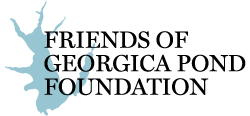By Dr. Stuart Waugh, Dr. Chris Gobler and Caitlin Asato
The New York Center For Clean Water Technology
If you’re planning to install a new low-nitrogen septic system, the addition of a simple box of woodchips to the system can remove even more nitrogen before the effluent reaches Georgica Pond.

Excess nitrogen from fertilizers, cesspools and septic systems and atmospheric deposition has led to deteriorating water quality in Long Island’s lakes, estuaries and coastal embayments. The consequences of this eutrophication are becoming increasingly evident with harmful algal blooms reoccurring at high frequency and fish kills. Not so apparent are the effects on benthic ecosystems which suffer loss of diversity or complete removal (e.g., eel-grasses). Beyond environmental degradation, a number of epidemiological studies have linked nitrate- a form of nitrogen- with risk of cancers. The U.S. E.P.A. presently sets the nitrate standard in drinking water at < 10 mg-N L-1 because of the risk of methemoglobinemia (blue baby syndrome) in infants. However, recent epidemiological studies in Denmark and Spain have associated colorectal cancers with much lower drinking water nitrate concentrations—levels which are not uncommon in Long Island groundwater.
Fortunately, New York State, Suffolk County and East Hampton government officials have established and funded programs to remediate the nitrogen problem locally. Suffolk County’s Reclaim Our Water program makes available grants which in combination with NY State and East Hampton Town funding can offset much of the cost of upgrading polluting cesspools and septic systems to low nitrogen Innovative/Advance (I/A) onsite wastewater treatment systems. Such I/A systems can reduce nitrogen concentrations from 40- 100+ mg- N L-1 in raw wastewater to < 19 mg- N L-1. Such reduction may help mitigate LI’s nitrogen problem over the long-term but there is evidence that even lower nitrogen concentrations will be necessary to fully remediate eutrophication in all LI waters. Some places like Georgica Pond where the travel time between cesspools/septic systems and the Pond is short could benefit from further reductions of nitrogen in the final effluent beyond those offered by I/A systems.

The NYS Center for Clean Water Technology at Stony Brook University (the “Center”) has been working with Suffolk County to develop ‘woodchip box polishing units’ which when coupled to I/A systems reduce total nitrogen to even lower levels. Woodchip boxes are typically comprised of a septic tank filled with woodchips placed between the new I/A system and final deposition galleys or rings. They work by removing most of the remaining nitrate from I/A effluent. According to Suffolk County’s Reclaim Our Water website systems such as Fuji Clean or Hydro-Action on average generated total nitrogen in final effluent of 9.43 and 11.2 mg- N L-1 in 2019. Based on these results, a woodchip box polishing unit coupled to either of these systems and removing 80% of this residual nitrate would have total nitrogen in final effluent of < 5 mg- N L-1. Based on published research, woodchips used in the boxes are expected to last for decades.
This very simple but effective technology comprises only a fraction of the total new septic system cost. Consequently, these polishing units may represent a valuable tool in addressing eutrophication in Georgica Pond.
